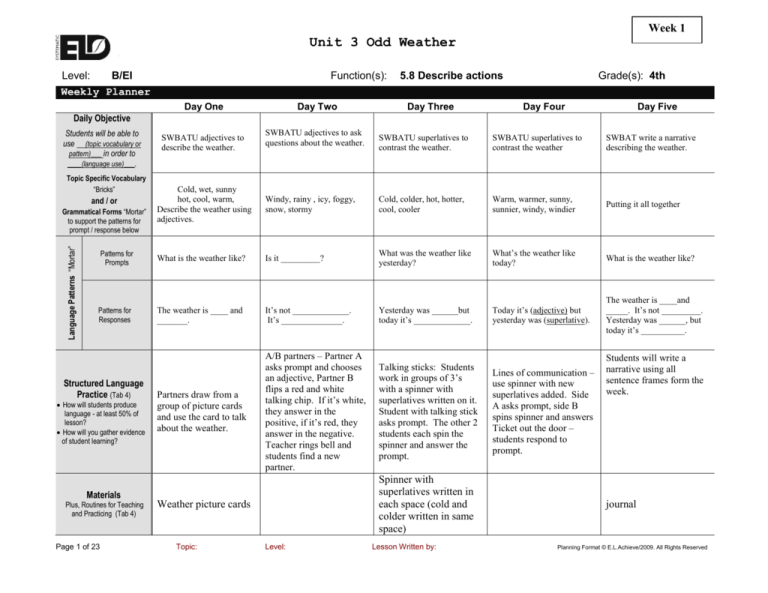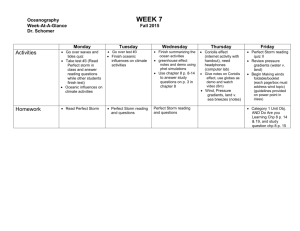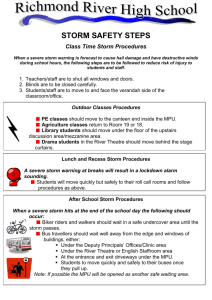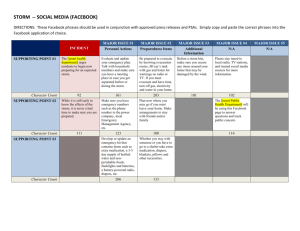
Week 1
Unit 3 Odd Weather
h
B/EI
Level:
Weekly Planner
Function(s):
Day One
Day Two
5.8 Describe actions
Day Three
Grade(s): 4th
Day Four
Day Five
Daily Objective
Students will be able to
use (topic vocabulary or
pattern)___ in order to
____(language use)___.
Topic Specific Vocabulary
“Bricks”
SWBATU adjectives to ask
questions about the weather.
SWBATU superlatives to
contrast the weather.
SWBATU superlatives to
contrast the weather
SWBAT write a narrative
describing the weather.
Cold, wet, sunny
hot, cool, warm,
Describe the weather using
adjectives.
Windy, rainy , icy, foggy,
snow, stormy
Cold, colder, hot, hotter,
cool, cooler
Warm, warmer, sunny,
sunnier, windy, windier
Putting it all together
Patterns for
Prompts
What is the weather like?
Is it _________?
What was the weather like
yesterday?
What’s the weather like
today?
What is the weather like?
Patterns for
Responses
The weather is ____ and
_______.
It’s not _____________.
It’s ______________.
Yesterday was ______but
today it’s _____________.
Today it’s (adjective) but
yesterday was (superlative).
The weather is ____and
_____. It’s not _________.
Yesterday was ______, but
today it’s __________.
Partners draw from a
group of picture cards
and use the card to talk
about the weather.
A/B partners – Partner A
asks prompt and chooses
an adjective, Partner B
flips a red and white
talking chip. If it’s white,
they answer in the
positive, if it’s red, they
answer in the negative.
Teacher rings bell and
students find a new
partner.
Talking sticks: Students
work in groups of 3’s
with a spinner with
superlatives written on it.
Student with talking stick
asks prompt. The other 2
students each spin the
spinner and answer the
prompt.
Lines of communication –
use spinner with new
superlatives added. Side
A asks prompt, side B
spins spinner and answers
Ticket out the door –
students respond to
prompt.
and / or
Grammatical Forms “Mortar”
to support the patterns for
prompt / response below
Language Patterns “Mortar”
SWBATU adjectives to
describe the weather.
Structured Language
Practice (Tab 4)
How will students produce
language - at least 50% of
lesson?
How will you gather evidence
of student learning?
Materials
Plus, Routines for Teaching
and Practicing (Tab 4)
Page 1 of 23
Spinner with
superlatives written in
each space (cold and
colder written in same
space)
Weather picture cards
Topic:
Level:
Lesson Written by:
Students will write a
narrative using all
sentence frames form the
week.
journal
Planning Format © E.L.Achieve/2009. All Rights Reserved
Week 1
Unit 3 Odd Weather
I Do It
Model New Language
I/We Do It
Model and Monitor Practice
You Do It:
Structured Independent Practice
3 - 6 minutes
5 -7 minutes
8-12 minutes
10 – 15 minutes
Wrap-Up & Reflection
3 - 5 minutes
Day Five
Day Four
Day Three
Day Two
Day One
Opening: Bring to Life
& State Objective
Page 2 of 23
Topic:
Level:
Lesson Written by:
Planning Format © E.L.Achieve/2009. All Rights Reserved
Unit 3 Odd Weather
Ongoing Assessment of Language Practice
Week 1
Directions: List target grammatical form(s) below. As you monitor target language practice, note whether
student is:
ELD Level(s):
Today it’s
(adjective)
but
yesterday
was
(superlative)
.
Language Function:
Yesterday
was
______but
today it’s
__________
___.
The weather
is ____ and
_______.
Teacher:
Able to produce language using scaffolds = —
It’s not ______
It’s _________.
Unable to produce language = 0
Able to produce language independently = I
Notes
Date:
1.
2.
3.
4.
5.
6.
7.
8.
9.
10.
11.
12.
13.
14.
15.
16.
17.
18.
19.
© E.L.Achieve/2007. All Rights Reserved
Planning for ELD Instruction
3.3
Unit 3 Odd Weather
Page 4 of 23
Topic:
Level:
Lesson Written by:
Planning Format © E.L.Achieve/2009. All Rights Reserved
Week 2
Unit 3 Odd Weather
B/Ei
Level:
Weekly Planner
Function(s):
Topic Specific Vocabulary
“Bricks”
and / or
Language Patterns “Mortar”
Grammatical Forms “Mortar”
to support the patterns for
prompt / response below
Patterns for
Prompts
Patterns for
Responses
Structured Language
Practice (Tab 4)
How will students produce
language - at least 50% of
lesson?
How will you gather evidence
of student learning?
Day Two
Day Three
Day Four
SWBATU verb phrases to
describe actions during
different weather.
SWBATU the word “don’t” with
verb phrases to describe actions
that they don’t do during
different weather.
SWBATU conjunctions to link 2
sentences in order to describe
actions during different weather.
SWBATU adverbs to describe
actions during different weather.
SWBAT write a narrative
describing what they do and
don’t do during a specific
weather event.
All frames
(Adjectives from last week. )
run to my house, play outside,
play in the puddles/snow,
throw snowballs at my friends,
slide on the sidewalk, hide
under my bed
go for a swim, stay inside, wear
_______(shorts, a jacket, a scarf,
gloves), walk in the sand
But, and
Adverbs: quickly, quietly,
slowly, carefully
What do you do when it’s
_(adjective)_?
What do you do when it’s
(adjective)?
What do you do when it’s
(adjective)?
What do you do when
it’s_(adjective)?
What do you do when it’s
snowy?
What do you do when it’s
stormy?
When it’s (adjective)_, I (verb
phrase)
When it’s snowy, I throw
snowballs at my friends.
Page 5 of 23
When it’s (adjective), I don’t
_________.
When it’s stormy, I don’t play
outside.
Partners use picture cards to
answer prompt. One partner
asks prompt after choosing a
picture card. The other partner
answers prompt.
Clock appointments-students
make clock appointments. Then
they write 1 weather adjective
on each line of their clock
appointment page. At each
appointment, they will ask the
prompt with the weather word in
that spot. Their partner answers
in the negative.
Weather picture cards
Copies of clock appointment
page
Materials
Plus, Routines for Teaching
and Practicing (Tab 4)
Grade(s): 4th
Day One
Daily Objective
Students will be able to
use (topic vocabulary or
pattern)___ in order to
____(language use)___.
5.10 Describe Actions
Topic:
Level:
What do you do when it’s
stormy?
When it’s (adjective), I (verb
phrase) (adverb) but I don’t
(verb phrase).
When it’s hot, I walk in the
sand slowly, but I don’t throw
snowballs.
Lines of communication – Side
A chooses and adjective and
asks prompt, Side B answers
while using a conjunction.
Lesson Written by:
When it’s (adjective), I (verb +
preposition) (adverb).
When it’s rainy I run to my
house quickly.
When it’s rainy, I don’t walk to
my house slowly.
Day Five
What do you do when it
_____________?
When it’s rainy, I run to my
house quickly and I don’t play
outside.
When it’s snowy, I throw
snowballs at my friends
carefully but I don’t go for a
swim.
Talking sticks: Students work in
groups of 3’s with a spinner with
adverbs written on it. Student
with talking stick asks prompt.
The other 2 students each spin
the spinner and answer the
prompt using their adverb in the
sentence.
Students write a narrative
describing what they do during a
specific weather event.
Spinner w/adverbs
journal
Planning Format © E.L.Achieve/2009. All Rights Reserved
Week 2
Unit 3 Odd Weather
I Do It
Model New Language
I/We Do It
Model and Monitor Practice
You Do It:
Structured Independent Practice
3 - 6 minutes
5 -7 minutes
8-12 minutes
10 – 15 minutes
Wrap-Up & Reflection
3 - 5 minutes
Day Five
Day Four
Day Three
Day Two
Day One
Opening: Bring to Life
& State Objective
Page 6 of 23
Topic:
Level:
Lesson Written by:
Planning Format © E.L.Achieve/2009. All Rights Reserved
Unit 3 Odd Weather
Ongoing Assessment of Language Practice
Week 2
Directions: List target grammatical form(s) below. As you monitor target language practice, note whether
student is:
ELD Level(s):
When it’s
(adjective), I
(verb +
preposition)
(adverb).
Language Function:
When it’s
(adjective), I don’t
_________.
When it’s
(adjective)_, I
(verb phrase)
Teacher:
When it’s
(adjective), I
(verb phrase)
(adverb) but I
don’t (verb
phrase).
Able to produce language using scaffolds = —
Unable to produce language = 0
Able to produce language independently = I
Notes
Date:
1.
2.
3.
4.
5.
6.
7.
8.
9.
10.
11.
12.
13.
14.
15.
16.
17.
18.
19.
Page 7 of 23
Topic:
Level:
Lesson Written by:
Planning Format © E.L.Achieve/2009. All Rights Reserved
Unit 3 Odd Weather
Level:
Week 3
Grade(s):
4/5
Function(s): 5.16
Describing routine events,
B/EI
Weekly Planner
Day One
Day Two
Day Three
Day Four
Day Five
Daily Objective
Students will be able to
use (topic vocabulary or
pattern)___ in order to
____(language use)___.
Topic Specific Vocabulary
“Bricks”
and / or
Language Patterns “Mortar”
Grammatical Forms “Mortar”
to support the patterns for
prompt / response below
Patterns for
Prompts
SWBATU specific nouns and
prepositions in the first
person to describe how to
stay safe during a storm.
a radio, a flashlight, candles,
extra food,
extra water,
inside, away from windows,
with my family
How do you stay safe inside
your house during a storm?
SWBATU specific nouns in
“we” form to describe how to
stay safe during a storm
SWBAT ask each other
questions to describe what they
have and don’t have to be ready
for a storm.
Trees, water, metal, tall objects,
shelter, a safe place, a way home
matches, extra blankets,
batteries, a safety plan
any
How do we stay safe outside
during a lightening storm?
Ask your partner a question
about staying safe during a
storm.
Do you have________?
Patterns for
Responses
Page 8 of 23
I keep __________ nearby.
I stay____________ .
Topic:
We stay away from _______.
We find ___________.
Level:
Yes, I have_______.
No, I don’t have a/any________.
Lesson Written by:
SWBATU sequence words to
describe what to do during a
storm.
SWBAT design a poster
describing how to stay safety
during a storm.
First, Next, Then, Finally,
What do you/we do if your
inside/outside during a storm?
First, you/we ________.
Next, you/we ________.
Then, you/we_________.
Finally, you/we_______.
Design a safety poster that
describes how to stay safety
during a storm.
What to do during a _______
storm if you are inside/outside.
First, we find a flashlight. Next,
we find extra water. Then we
stay away from the windows.
Finally, we stay inside.
Planning Format © E.L.Achieve/2009. All Rights Reserved
Unit 3 Odd Weather
Structured Language
Practice (Tab 4)
How will students produce
language - at least 50% of
lesson?
How will you gather evidence
of student learning?
A/B partners meet w/Partner A
asking prompt and Partner B
making up a response.
Talking sticks in groups of 3s.
Person with talking stick asks
prompt. Then they pass stick
and each member gives a
response.
In groups of 3s, play “Go fish”
with set of “supply” cards. Pass
out 6 cards to each student.
Student asks another person “Do
you have _____?” That person
responds, “Yes, I have ______.”
if the card is in their hand. They
give the card to the partner who
gets to put it in their hand. If
they don’t have the card, “No, I
don’t have a/any___.”
A/B partners interview each
other using cloze answer form.
Partner A asks, “What do
you/we do if your inside/outside
during a storm?”
Partner B uses Cloze form to
answer.
Talking sticks
Sets of word cards for each
group of 3 students
Cloze answers forms for ½ the
class
Materials
Plus, Routines for Teaching
and Practicing (Tab 4)
Page 9 of 23
Topic:
Level:
Lesson Written by:
White construction paper
Planning Format © E.L.Achieve/2009. All Rights Reserved
Week 3
Unit # 3
Oddd Weather
I Do It
Model New Language
I/We Do It
Model and Monitor Practice
You Do It:
Structured Independent Practice
3 - 6 minutes
5 -7 minutes
8-12 minutes
10 – 15 minutes
Wrap-Up & Reflection
3 - 5 minutes
Day Five
Day Four
Day Three
Day Two
Day One
Opening: Bring to Life
& State Objective
© E.L.Achieve/2007. All Rights Reserved
Planning for ELD Instruction
3.10
Week 3
Unit # 3 Odd Weather
Ongoing Assessment of Language Practice
Directions: List target grammatical form(s) below. As you monitor target language practice, note whether
student is:
Date:
Able to produce language independently = I
Sequence
words
Yes, I
have_______.
No, I don’t
have
a/any_______
_.
Do you
have_______
_?
ELD Level(s):
We find
___________.
Language Function:
I stay____________
.
I keep
__________
nearby.
Teacher:
We stay away
from
_______.
Able to produce language using scaffolds = —
Unable to produce language = 0
Notes
1.
2.
3.
4.
5.
6.
7.
8.
9.
10.
11.
12.
13.
14.
15.
16.
17.
18.
19.
Page 11 of 23
Topic:
Level:
Lesson Written by:
Planning Format © E.L.Achieve/2009. All Rights Reserved
Unit # 3 Odd Weather
12
Page 12 of 23
Topic:
Level:
Lesson Written by:
Planning Format © E.L.Achieve/2009. All Rights Reserved
Week 4
Unit # 3 Odd Weather
B/EI
Level:
Weekly Planner
Function(s):
Day One
Day Two
5.20 Discuss time using clocks,
calendars and timelines
Grade(s): 4/5
Day Three
Day Four
Day Five
SWBATU months of the year to
describe when storms occur.
SWBATU specific times of day
to describe when storms occur.
SWBAT describe when odd
weather events happen during
the year.
day, afternoon, evening, night,
Hurricanes – day and night
Tornadoes – evening and night
Thunderstorm – afternoon and
evening
Hailstorm – afternoon and
evening
All
Daily Objective
Students will be able to
use (topic vocabulary or
pattern)___ in order to
____(language use)___.
Topic Specific Vocabulary
“Bricks”
and / or
Language Patterns “Mortar”
Grammatical Forms “Mortar”
to support the patterns for
prompt / response below
Patterns for
Prompts
Patterns for
Responses
Structured Language
Practice (Tab 4)
How will students produce
language - at least 50% of
lesson?
How will you gather evidence
of student learning?
Materials
Plus, Routines for Teaching
and Practicing (Tab 4)
Page 13 of 23
SWBATU adjectives and
nouns to describe different
types of storms.
Hurricane - storm with very
strong wind
Tornado – storm with rotating
wind
Thunderstorm – storm with
lightening and thunder
Hailstorm – storm with balls of
ice
SWBATU the 4 seasons to
describe when storms occur.
Winter, spring, summer fall
Hurricanes – summer and fall
Tornadoes – Spring
Thunderstorm – Spring and
summer
Hailstorm - Winter
Months of the year (taught in
conjunction with their seasons)
During what months do (specific
storm) usually occur?
During what time of day
are_(specific storm) most likely
to occur?
What is a _________?
When do _(storm name)_ occur?
What is a tornado?
When do tornadoes occur?
During what months do
tornadoes usually occur?
A _______________ is a storm
with __________.
____________occur most often
in the ______.
They usually occur from
(month) to (month).
(Specific storm) usually occur
in the (time of day).
A tornado is a storm with
rotating wind.
Tornadoes occur most often in
the Spring and summer.
They usually occur from March
to June.
Tornadoes usually occur in the
evening and night.
Groups of 3-4 using a spinner
with the 4 different storm
names.
Student who spins asks the
person next to them the
prompt. That student answers.
Then they pass spinner to next
person.
A/B partners
Partner A has an index
card with a storm name
and asks prompt.
Partner B answers.
A/B partners
Partner A has an index
card with a storm name
and asks prompt.
Partner B answers.
Groups of 3-4 using a spinner
with the 4 different storm names.
Student who spins asks the
person next to them the prompt.
That student answers. Then they
pass spinner to next person.
Spinners with storm
names written on
them.
Storm chart
Index cards with storm
names written on them
Index cards with storm
names written on them
Spinners with storm
names written on them.
Storm chart
Topic:
Level:
Lesson Written by:
Describe a storm and explain
when it occurs.
During what time of day are
tornadoes most likely to occur?
A thunderstorm is a storm with
lightening and thunder.
Thunderstorm occur most often
in the spring and the summer.
They usually occur from March
to August.
Students write a
description about a
storm in their journal.
Planning Format © E.L.Achieve/2009. All Rights Reserved
Week 4
Unit # 3 Odd Weather
I Do It
Model New Language
I/We Do It
Model and Monitor Practice
You Do It:
Structured Independent Practice
3 - 6 minutes
5 -7 minutes
8-12 minutes
10 – 15 minutes
Wrap-Up & Reflection
3 - 5 minutes
Day Five
Day Four
Day Three
Day Two
Day One
Opening: Bring to Life
& State Objective
Page 14 of 23
Topic:
Level:
Lesson Written by:
Planning Format © E.L.Achieve/2009. All Rights Reserved
Unit # 3 Odd weather
Ongoing Assessment of Language Practice
Week 4
Directions: List target grammatical form(s) below. As you monitor target language practice, note whether
student is:
ELD Level(s):
Date:
(Specific
storm) usually
occur in the
(time of day).
Language Function:
They usually
occur from
(month) to
(month).
Teacher:
Able to produce language using scaffolds = —
A
___________
____ is a
storm with
__________.
____________occur
most often in the
______.
Unable to produce language = 0
Able to produce language independently = I
Notes
1.
2.
3.
4.
5.
6.
7.
8.
9.
10.
11.
12.
13.
14.
15.
16.
17.
18.
© E.L.Achieve/2007. All Rights Reserved
Planning for ELD Instruction
3.15
Language Function:
ELD Level(s):
19.
(Specific
storm) usually
occur in the
(time of day).
Teacher:
They usually
occur from
(month) to
(month).
A
___________
____ is a
storm with
__________.
____________occur
most often in the
______.
Unit 3 Odd Weather
Notes
Weekly Planner
Day One
Day Two
Day Three
Day Four
Day Five
Daily Objective
Students will be able to
use (topic vocabulary or
pattern)___ in order to
____(language use)___.
Topic Specific Vocabulary
“Bricks”
and / or
Language Patterns “Mortar”
Grammatical Forms “Mortar”
to support the patterns for
prompt / response below
Patterns for
Prompts
to re-teach
Patterns for
Responses
to re-teach
Structured Language
Practice (Tab 4)
How will students produce
language - at least 50% of
lesson?
How will you gather evidence
of student learning?
Page 16 of 23
Week 5
Topic:
Level:
Lesson Written by:
Re-teach or Assess
Planning Format © E.L.Achieve/2009. All Rights Reserved
Unit 3 Odd Weather
Materials
Plus, Routines for Teaching
and Practicing (Tab 4)
Page 17 of 23
Topic:
Level:
Lesson Written by:
Planning Format © E.L.Achieve/2009. All Rights Reserved
Unit 3 Odd Weather
Week 5
Re-teach or Assess
I Do It
Model New Language
I/We Do It
Model and Monitor Practice
You Do It:
Structured Independent Practice
Wrap-Up & Reflection
3 - 6 minutes
5 -7 minutes
8-12 minutes
10 – 15 minutes
3 - 5 minutes
Day Five
Day Four
Day Three
Day Two
Day One
Opening: Bring to Life
& State Objective
Page 18 of 23
Topic:
Level:
Lesson Written by:
Planning Format © E.L.Achieve/2009. All Rights Reserved
Unit 3 Odd Weather
Week 3 Supply cards
Print two sets for each group of students.
a radio
a flashlight matches
extra food extra water blankets
batteries
Page 19 of 23
Topic:
safety plan candles
Level:
Lesson Written by:
Planning Format © E.L.Achieve/2009. All Rights Reserved
Unit 3 Odd Weather
Week 3 Cloze Interview answer form
First, you/we ________________.
Next, you/we ________________.
Then, you/we________________.
Finally, you/we______________.
Page 20 of 23
Topic:
Level:
Lesson Written by:
Planning Format © E.L.Achieve/2009. All Rights Reserved
Unit 3 Odd Weather
Week 4 Storm Chart
Storm name
Description
When it
occurs
(season)
What month
it occurs in
What time of
day it occurs
Hurricane
Tornado
Hailstorm
Thunderstorm
Page 21 of 23
Topic:
Level:
Lesson Written by:
Planning Format © E.L.Achieve/2009. All Rights Reserved
Unit 3 Odd Weather
Page 22 of 23
Topic:
Level:
Lesson Written by:
Weather Picture Cards
Planning Format © E.L.Achieve/2009. All Rights Reserved
Unit 3 Odd Weather
Page 23 of 23
Topic:
Level:
Lesson Written by:
Planning Format © E.L.Achieve/2009. All Rights Reserved





